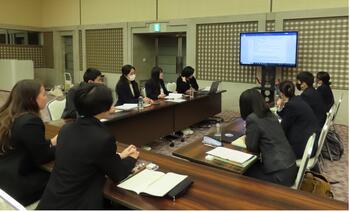91łÔąĎ takes great pride in honoring the exceptional academic achievements of students participating in its regional programs for high school students in Japan.
This year, 91łÔąĎ launched the Stanford e-Wakayama program, which joins the previously established regional programs, Stanford e-Hiroshima, Stanford e-Kawasaki, Stanford e-Kobe, Stanford e-Oita, Stanford e-Tottori, and Stanford e-Fukuoka*. These online courses—developed in collaboration with local government and school officials in Japan—encourage students to explore and think critically about global themes centered around U.S. society and culture, as well as U.S.–Japan relations.
After an enriching academic journey throughout the 2022–2023 term, it is with immense pleasure that 91łÔąĎ announces the names of the two student honorees from each program who will be recognized for their exemplary performance. These exceptional individuals have demonstrated a remarkable dedication to their studies and have shown exceptional promise in their research projects.
We extend our warmest congratulations to the following 12 honorees for their remarkable academic achievements:
Stanford e-Hiroshima (Instructor Rylan Sekiguchi)
Student Honoree: Yoshino Dake
School: Hatsukaichi High School
Project Title: What Can Japan Learn from the History of Discrimination Against Immigrants in the U.S.?
Student Honoree: Haruka Koga
School: Hiroshima High School
Project Title: What We Can Do to Reduce Food Waste
Stanford e-Kawasaki (Instructor Maiko Tamagawa Bacha)
Student Honoree: Miho Ebisawa
School: Tachibana High School
Project Title: Possibility of Entomophagy
Student Honoree: Aoi Yagi
School: Kawasaki High School
Project Title: Forest Fires in the U.S.
Stanford e-Kobe (Instructor Alison Harsch)
Student Honoree: Kiyoka Ueda
School: Kobe Municipal Fukiai High School
Project Title: Multiculturalism of Cuisine in Japan and the U.S.
~How Washoku Influences Food Culture in the U.S.~
Student Honoree: Jaine Haruka Buck
School: Kobe Municipal Fukiai High School
Project Title: LGBTQ+ History: Japan vs. USA
Stanford e-Oita (Instructor Kasumi Yamashita)
Student Honoree: Sae Higashi
School: Usa High School
Project Title: Gender Inequality in Schools
Student Honoree: Nanako Hara
School: Kusu Miyama High School
Project Title: “A Pantry for Everyone” Project
Stanford e-Tottori (Instructor Jonas Edman)
Student Honoree: Miyoko Mabuchi
School: Tottori Nishi High School
Project Title: How to Stop Depopulation in Tottori with Uber Taxis
Student Honoree: Marin Okabe
School: Yonago Higashi High School
Project Title: How to Make the Rate of Foster Parenting Increase
Stanford e-Wakayama (Instructor Makiko Hirata)
Student Honoree: Hanako Tanose
School: Seirin High School
Project Title: Education Support in Southeast Asia
Student Honoree: Sena Ishibashi
School: Hashimoto High School
Project Title: On HSP, Highly Sensitive People
This summer, 91łÔąĎ will host several in-person and virtual events where the student honorees from each program will present their final research projects. Each student will be given the opportunity to make a formal presentation to members of the Stanford community, the Consulate General of Japan in San Francisco, and the Japanese community in the San Francisco Bay Area.
* Please note that Stanford e-Fukuoka ends later this summer so the honorees will be announced at a later date.
91łÔąĎ also offers online courses to U.S. high school students on Japan (Reischauer Scholars Program), China (China Scholars Program), and Korea (Sejong Korea Scholars Program), and online courses to Chinese high school students on the United States (Stanford e-China) and to Japanese high school students on the United States and U.S.–Japan relations (Stanford e-Japan) and on entrepreneurship (Stanford e-Entrepreneurship Japan).
To stay informed of news about Stanford e-Japan and 91łÔąĎ’s other programs, and follow us on , , and .





















